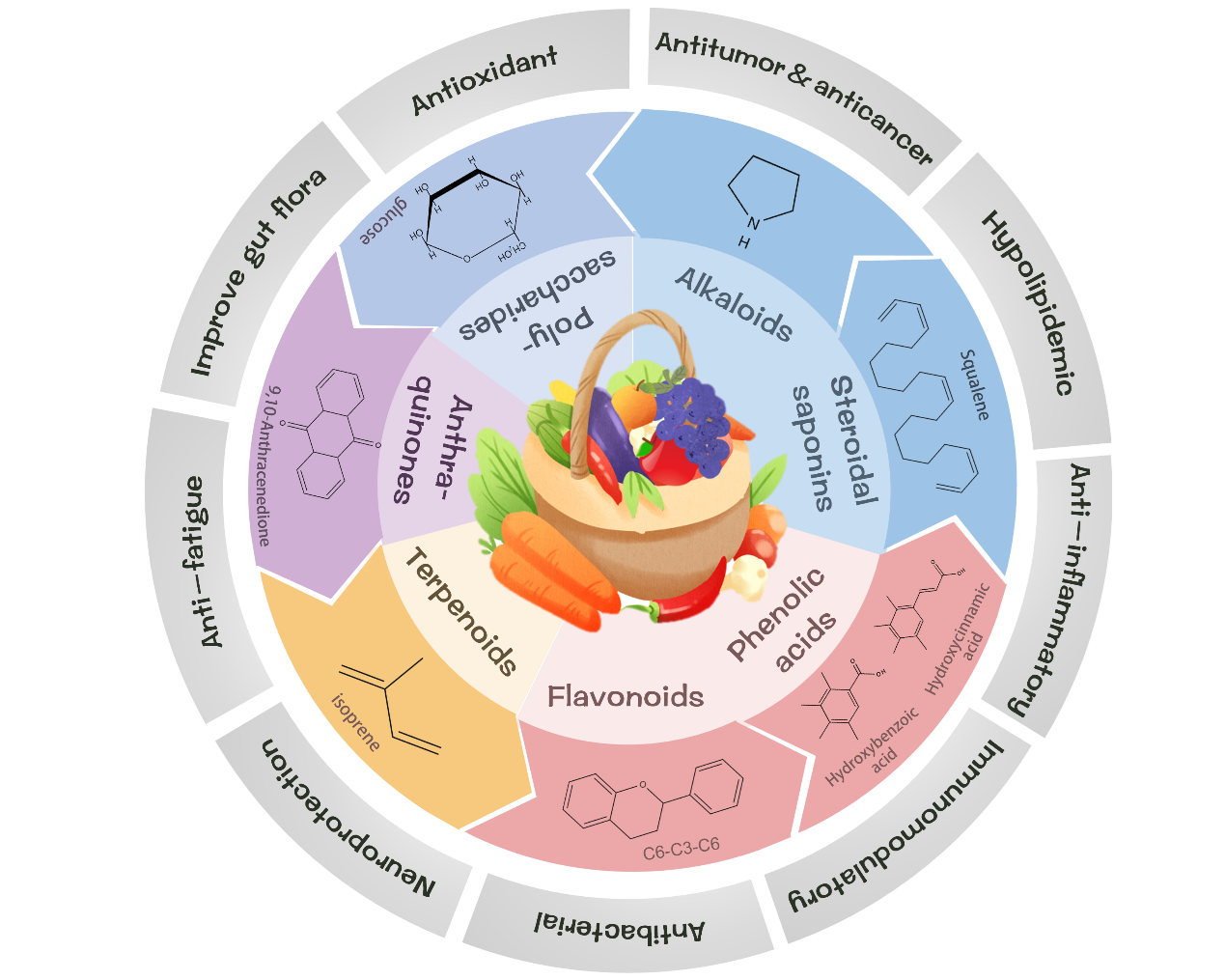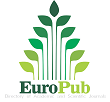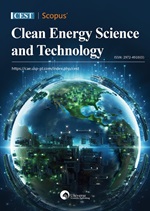Research progress on bioactive components and functions of fruits and vegetables
DOI:
https://doi.org/10.18686/fnc.v1i1.14Keywords:
fruits and vegetables; bioactivity; function; secondary metabolismAbstract
Globally, humans are at risk of increasing incidence of metabolic diseases, the occurrence of which is closely linked to people’s daily diet. Fruits and vegetables are among the important daily food types for people. Varieties of plants’ secondary metabolites are contained in fruits and vegetables, including phenolic acids, flavonoids, anthraquinones, terpenoids, alkaloids, steroidal saponins, and polysaccharides. These metabolites usually have multiple bioactive functions, such as antioxidant, antitumor, hypoglycemic, hypolipidemic, neuroprotection, anti-inflammatory, antibacterial, and disease prevention, which are of great importance in preventing the occurrence of human metabolic diseases. However, the composition, content, bioactive functions, and mechanisms of action of these metabolites in different types of fruits and vegetables vary greatly. The progress of the research on the main bioactive components of fruits and vegetables and their multi-functions is reviewed in this paper to promote people’s understanding and utilization of the functional components of fruits and vegetables.

Downloads
Published
How to Cite
Issue
Section
License
Copyright (c) 2023 Yubei Wang, Shihao Li, Kexin Li , Peiye Liu , Jiankang Cao

This work is licensed under a Creative Commons Attribution-NonCommercial 4.0 International License.
References
1. Kumar N, Goel N. Phenolic acids: Natural versatile molecules with promising therapeutic applications. Biotechnology Reports 2019; 24: e00370. doi: 10.1016/j.btre.2019.e00370
2. Shen N, Wang T, Gan Q, et al. Plant flavonoids: Classification, distribution, biosynthesis, and antioxidant activity. Food Chemistry 2022; 383: 132531. doi: 10.1016/j.foodchem.2022.132531
3. Diaz-Muñoz G, Miranda IL, Sartori SK, et al. Anthraquinones: An overview. Studies in Natural Products Chemistry 2018; 313–338. doi: 10.1016/b978-0-444-64056-7.00011-8
4. Toll D. Biosynthesis and biological functions of terpenoids in plants. Advances in Biochemical Engineering/Biotechnology 2014; 123: 127–141.
5. Savla P, Das G, Mondal P, et al. Methanolic extract of papaya leaves shows neuroprotective effect. ChemistrySelect 2017; 2(29): 9454–9457. doi: 10.1002/slct.201701656
6. Xie H, Shi X, Wang B, et al. Steroidal saponins from Allium chinense and their inhibitory effects on pancreatic lipase. Phytochemistry Letters 2023; 55: 22–29. doi: 10.1016/j.phytol.2023.03.002
7. Monsalve B, Concha-Meyer A, Palomo I, et al. Mechanisms of endothelial protection by natural bioactive compounds from fruit and vegetables. Anais da Academia Brasileira de Ciências 2017; 89(1 suppl): 615–633. doi: 10.1590/0001-3765201720160509
8. Majerska J, Michalska A, Figiel A. A review of new directions in managing fruit and vegetable processing by-products. Trends in Food Science & Technology 2019; 88: 207–219. doi: 10.1016/j.tifs.2019.03.021
9. Ferreira LF, Minuzzi NM, Rodrigues RF, et al. Citric acid water-based solution for blueberry bagasse anthocyanins recovery: Optimization and comparisons with microwave-assisted extraction (MAE). LWT 2020; 133: 110064. doi: 10.1016/j.lwt.2020.110064
10. Zhang X, Wang S, Wu Q, et al. Recovering high value-added anthocyanins from blueberry pomace with ultrasound-assisted extraction. Food Chemistry: X 2022; 16: 100476. doi: 10.1016/j.fochx.2022.100476
11. Xue H, Xu H, Wang X, et al. Effects of microwave power on extraction kinetic of anthocyanin from blueberry powder considering absorption of microwave energy. Journal of Food Quality 2018; 2018: 1–13. doi: 10.1155/2018/9680184
12. Elez Garofulić I, Repajić M, Zorić Z, et al. Evaluation of microwave- and ultrasound-assisted extraction techniques for revalorization of black chokeberry (aronia melanocarpa) fruit pomace anthocyanins. Sustainability 2023; 15(9): 7047. doi: 10.3390/su15097047
13. Sun Y, Qiao L, Shen Y, et al. Phytochemical Profile and antioxidant activity of physiological drop of citrus fruits. Journal of Food Science 2013; 78(1). doi: 10.1111/j.1750-3841.2012.03002.x
14. Wang X, Li C, Liang D, et al. Phenolic compounds and antioxidant activity in red-fleshed apples. Journal of Functional Foods 2015; 18: 1086–1094. doi: 10.1016/j.jff.2014.06.013
15. Fan E, Zhang K, Jiang S, et al. Analysis of trans-resveratrol in grapes by micro-high performance liquid chromatography. Analytical Sciences 2008; 24(8): 1019–1023. doi: 10.2116/analsci.24.1019
16. López-Cobo A, Gómez-Caravaca AM, Pasini F, et al. HPLC-DAD-ESI-QTOF-MS and HPLC-FLD-MS as valuable tools for the determination of phenolic and other polar compounds in the edible part and by-products of avocado. LWT 2016; 73: 505–513. doi: 10.1016/j.lwt.2016.06.049
17. Barreca D, Bellocco E, Leuzzi U, et al. First evidence of C- and O-glycosyl flavone in blood orange (Citrus sinensis (L.) Osbeck) juice and their influence on antioxidant properties. Food Chemistry 2014; 149: 244–252. doi: 10.1016/j.foodchem.2013.10.096
18. Tian JL, Si X, Wang YH, et al. Bioactive flavonoids from Rubus corchorifolius inhibit α-glucosidase and α-amylase to improve postprandial hyperglycemia. Food Chemistry. 2021; 341: 128149. doi: 10.1016/j.foodchem.2020.128149
19. Feng J, Yi X, Huang W, et al. Novel triterpenoids and glycosides from durian exert pronounced anti-inflammatory activities. Food Chemistry 2018; 241: 215–221. doi: 10.1016/j.foodchem.2017.08.097
20. Nie XR, Fu Y, Wu DT, et al. Ultrasonic-assisted extraction, structural characterization, chain conformation, and biological activities of a pectic-polysaccharide from okra (abelmoschus esculentus). Molecules 2020; 25(5): 1155. doi: 10.3390/molecules25051155
21. Hiranvarachat B, Devahastin S, Chiewchan N, et al. Structural modification by different pretreatment methods to enhance microwave-assisted extraction of β-carotene from carrots. Journal of Food Engineering 2013; 115(2): 190–197. doi: 10.1016/j.jfoodeng.2012.10.012
22. Sereno AB, Bampi M, dos Santos IE, et al. Mineral profile, carotenoids and composition of cocona (Solanum sessiliflorum Dunal), a wild Brazilian fruit. Journal of Food Composition and Analysis 2018; 72: 32–38. doi: 10.1016/j.jfca.2018.06.001
23. Sun Y, Liu D, Chen J, et al. Effects of different factors of ultrasound treatment on the extraction yield of the all-trans-β-carotene from citrus peels. Ultrasonics Sonochemistry. 2011; 18(1): 243–249. doi: 10.1016/j.ultsonch.2010.05.014
24. Gong G, Dang T, Deng Y, et al. Physicochemical properties and biological activities of polysaccharides from Lycium barbarum prepared by fractional precipitation. International Journal of Biological Macromolecules 2018; 109: 611–618. doi: 10.1016/j.ijbiomac.2017.12.017
25. Teng H, He Z, Li X, et al. Chemical structure, antioxidant and anti-inflammatory activities of two novel pectin polysaccharides from purple passion fruit (Passiflora edulia Sims) peel. Journal of Molecular Structure 2022; 1264: 133309. doi: 10.1016/j.molstruc.2022.133309
26. Bensaci N, Abdi A, Ben Aziza H, et al. Characterization and biological evaluation of Crataegus azarolus fruit polysaccharides. Journal of Molecular Structure 2022; 1270: 133889. doi: 10.1016/j.molstruc.2022.133889
27. Clifford MN, Wu W, Kuhnert N. The chlorogenic acids of Hemerocallis. Food Chemistry 2006; 95(4): 574–578. doi: 10.1016/j.foodchem.2005.01.045
28. Benbouguerra N, Richard T, Saucier C, et al. Voltammetric behavior, flavanol and anthocyanin contents, and antioxidant capacity of grape skins and seeds during ripening (Vitis vinifera var. Merlot, Tannat, and Syrah). Antioxidants 2020; 9(9): 800. doi: 10.3390/antiox9090800
29. Santiago‐López L, Hernández‐Mendoza A, Vallejo‐Cordoba B, et al. Food‐derived immunomodulatory peptides. Journal of the Science of Food and Agriculture 2016; 96(11): 3631–3641. doi: 10.1002/jsfa.7697
30. Huang XY, Wang CK, Zhao YW, et al. Mechanisms and regulation of organic acid accumulation in plant vacuoles. Horticulture Research 2021; 8(1). doi: 10.1038/s41438-021-00702-z
31. Tai CY, Chen BH. Analysis and stability of carotenoids in the flowers of daylily (Hemerocallis disticha) as affected by various treatments. Journal of Agricultural and Food Chemistry 2000; 48(12): 5962-5968. doi: 10.1021/jf000956t
32. Montesano D, Rocchetti G, Putnik P, et al. Bioactive profile of pumpkin: an overview on terpenoids and their health-promoting properties. Current Opinion in Food Science 2018; 22: 81–87. doi: 10.1016/j.cofs.2018.02.003
33. Kikuchi T, Takebayashi M, Shinto M, et al. Three new multiflorane-type triterpenes from pumpkin (Cucurbita maxima) seeds. Molecules 2013; 18(5): 5568–5579. doi: 10.3390/molecules18055568
34. Szewczyk K, Kalemba D, Miazga-Karska M, et al. The essential oil composition of selected Hemerocallis cultivars and their biological activity. Open Chemistry 2019; 17(1): 1412–1422. doi: 10.1515/chem-2019-0160
35. Qin S, Lv C, Wang Q, et al. Extraction, identification, and antioxidant property evaluation of limonin from pummelo seeds. Animal Nutrition 2018, 4(3): 281–287. doi: 10.1016/j.aninu.2018.05.005
36. Fang X, Wang H, Zhou X, et al. Transcriptome reveals insights into biosynthesis of ginseng polysaccharides. BMC Plant Biology 2022: 22. doi: 10.1186/s12870-022-03995-x
37. Ahmed HH, El-Abhar HS, Hassanin EAK, et al. Punica granatum L. suppresses colon cancer through downregulation of Wnt/β-catenin in rat model. Revista Brasileira de Farmacognosia 2017; 27(5): 627–635. doi: 10.1016/j.bjp.2017.05.010
38. Ramlagan P, Rondeau P, Planesse C, et al. Punica granatum L. mesocarp suppresses advanced glycation end products (AGEs)- and H2O2-induced oxidative stress and pro-inflammatory biomarkers. Journal of Functional Foods 2017; 29: 115–126. doi: 10.1016/j.jff.2016.12.007
39. Karwasra R, Singh S, Sharma D, et al. Pomegranate supplementation attenuates inflammation, joint dysfunction via inhibition of NF-κB signaling pathway in experimental models of rheumatoid arthritis. Journal of Food Biochemistry 2019; 43(8). doi: 10.1111/jfbc.12959
40. Chen NC, Chyau CC, Lee YJ, et al. Promotion of mitotic catastrophe via activation of PTEN by paclitaxel with supplement of mulberry water extract in bladder cancer cells. Scientific Reports 2016, 6: 1–13. doi: 10.1038/srep20417
41. Su D, Zhang R, Hou F, et al. Lychee pulp phenolics ameliorate hepatic lipid accumulation by reducing miR-33 and miR-122 expression in mice fed a high-fat diet. Food & Function 2017; 8: 808–815. doi: 10.1039/c6fo01507g
42. Vuolo MM, Lima GC, Batista ÂG, et al. Passion fruit peel intake decreases inflammatory response and reverts lipid peroxidation and adiposity in diet-induced obese rats. Nutrition Research 2020; 76: 106–117. doi: 10.1016/j.nutres.2019.08.007
43. Domínguez-Avila JA, Astiazaran-Garcia H, Wall-Medrano A, et al. Mango phenolics increase the serum apolipoprotein A1/B ratio in rats fed high cholesterol and sodium cholate diets. Journal of the Science of Food and Agriculture 2019; 99(4): 1604–1612. doi: 10.1002/jsfa.9340
44. Gao Z, Wang ZY, Guo Y, et al. Enrichment of polymethoxyflavones from Citrus reticulata ‘Chachi’ peels and their hypolipidemic effect. Journal of Chromatography B 2019; 1124: 226–232. doi: 10.1016/j.jchromb.2019.06.010
45. Apraj VD, Pandita NS. Evaluation of skin anti-aging potential of Citrus reticulata blanco peel. Pharmacognosy Research 2016; 8(3): 160–168. doi: 10.4103/0974-8490.182913
46. Choi J, Choi SY, Hong Y, et al. The central administration of vitisin a, extracted from Vitis vinifera, improves cognitive function and related signaling pathways in a scopolamine-induced dementia model. Biomedicine & Pharmacotherapy 2023; 163, 114812. doi: 10.1016/j.biopha.2023.114812
47. Yu X, Meng X, Yan Y, et al. Extraction of naringin from pomelo and its therapeutic potentials against hyperlipidemia. Molecules 2022, 27(24): 9033. doi: 10.3390/molecules27249033
48. Jiang J, Yan L, Shi Z, et al. Hepatoprotective and anti-inflammatory effects of total flavonoids of Qu Zhi Ke (peel of Citrus changshan-huyou) on non-alcoholic fatty liver disease in rats via modulation of NF-κB and MAPKs. Phytomedicine 2019; 64. doi: 10.1016/j.phymed.2019.153082
49. Oikeh EI, Oviasogie FE, Omoregie ES. Quantitative phytochemical analysis and antimicrobial activities of fresh and dry ethanol extracts of Citrus sinensis (L.) Osbeck (sweet Orange) peels. Clinical Phytoscience 2020; 6. doi: 10.1186/s40816-020-00193-w
50. Lu Q, Huang N, Peng Y, et al. Peel oils from three Citrus species: Volatile constituents, antioxidant activities and related contributions of individual components. Journal of Food Science and Technology 2019, 56: 4492–4502. doi: 10.1007/s13197-019-03937-w
51. Ekam VS, Udosen EO, Chigbu AE. Comparative effect of carotenoid complex from Golden Neo-Life Dynamite (GNLD) and carrot extracted carotenoids on immune parameters in albino Wistar rats. Nigerian Journal of Physiological Sciences 2006; 21(1-2): 1–4. doi: 10.4314/njps.v21i1-2.53930
52. Moo-Huchin VM, González-Aguilar GA, Moo-Huchin M, et al. Carotenoid composition and antioxidant activity of extracts from tropical fruits. Chiang Mai Journal of Science 2017; 44: 605–616.
53. Ma Y, Zhu D, Thakur K, et al. Antioxidant and antibacterial evaluation of polysaccharides sequentially extracted from onion (Allium cepa L.). International Journal of Biological Macromolecules 2018; 111: 92–101. doi: 10.1016/j.ijbiomac.2017.12.154
54. Rong Y, Yang R, Yang Y, et al. Structural characterization of an active polysaccharide of longan and evaluation of immunological activity. Carbohydrate Polymers 2019; 213: 247–256. doi: 10.1016/j.carbpol.2019.03.007
55. Zhong K, Wang Q, He Y, et al. Evaluation of radicals scavenging, immunity-modulatory and antitumor activities of longan polysaccharides with ultrasonic extraction on in S180 tumor mice models. International Journal of Biological Macromolecules 2010; 47(3): 356–360. doi: 10.1016/j.ijbiomac.2010.05.022
56. Bo B. Research on the influence of anti-fatigue effect and movement ability of blueberry polysaccharides on aged mice. The Open Biomedical Engineering 2015; 9: 314–317. doi: 10.2174/1874120701509010314
57. Rjeibi I, Feriani A, Hentati F, et al. Structural characterization of water-soluble polysaccharides from Nitraria retusa fruits and their antioxidant and hypolipidemic activities. International Journal of Biological Macromolecules 2019; 129: 422–432. doi: 10.1016/j.ijbiomac.2019.02.049
58. Ji X, Liu F, Peng Q, et al. Purification, structural characterization, and hypolipidemic effects of a neutral polysaccharide from Ziziphus Jujuba cv. Muzao. Food Chemistry 2018; 245: 1124–1130. doi: 10.1016/j.foodchem.2017.11.058
59. Zeng H, Chen P, Chang Q, et al. Hypolipidemic effect of polysaccharides from Fortunella margarita (Lour.) Swingle in hyperlipidemic rats. Food and Chemistry Toxicology 2019; 132: 110663. doi: 10.1016/j.fct.2019.110663
60. Lengsfeld C, Titgemeyer F, Faller G, et al. Glycosylated compounds from Okra inhibit adhesion of Helicobacter pylori to human gastric mucosa. Journal of Agricultural and Food Chemistry 2004; 52(6): 1495–1503. doi: 10.1021/jf030666n
61. Liu X, Liu J, Liu C, et al. Selenium-containing polysaccharides isolated from Rosa laevigata Michx fruits exhibit excellent anti-oxidant and neuroprotective activity in vitro. International Journal of Biological Macromolecules 2022; 209(Part A): 1222–1233. doi: 10.1016/j.ijbiomac.2022.04.146
62. Cichewicz RH, Nair MG. Isolation and characterization of stelladerol, a new antioxidant naphthalene glycoside, and other antioxidant glycosides from edible daylily (Hemerocallis) flowers. Journal of Agricultural and Food Chemistry 2002; 50(1): 87–91. doi: 10.1021/jf010914k
63. Martínez-Jiménez F, Muiños F, Sentís I, et al. A compendium of mutational cancer driver genes. Nature Reviews Cancer 2020; 20: 555–572. doi: 10.1038/s41568-020-0290-x
64. Greten FR, Grivennikov SI. Inflammation and cancer: Triggers, mechanisms, and consequences. Immunity 2019; 51(1): 27–41. doi: 10.1016/j.immuni.2019.06.025
65. Guo R, Chen M, Ding Y, et al. 2022. Polysaccharides as potential anti-tumor biomacromolecules—A review. Frontiers in Nutrition 2022; 9: 1–12. doi: 10.3389/fnut.2022.838179
66. Cichewicz RH, Zhang Y, Seeram NP, et al. Inhibition of human tumor cell proliferation by novel anthraquinones from daylilies. Life Sciences 2004; 74(14): 1791–1799. doi: 10.1016/j.lfs.2003.08.034
67. Medzhitov R. Origin and physiological roles of inflammation. Nature 2008; 454: 428–435. doi: 10.1038/nature07201
68. Liu X, Luo L, Liu B, et al. Ethanol extracts from Hemerocallis citrina attenuate the upregulation of proinflammatory cytokines and indoleamine 2,3-dioxygenase in rats. Journal of Ethnopharmacology 2014; 153(2): 484–490. doi: 10.1016/j.jep.2014.03.001
69. Xiao J, Zhang R, Huang F, et al. The biphasic dose effect of lychee (Litchi chinensis Sonn.) pulp phenolic extract on alcoholic liver disease in mice. Food & Function 2017; 1: 189–200. doi: 10.1039/c6fo01166g
70. Peng F, Ren X, Du B, et al. Insoluble dietary fiber of pear fruit pomace (Pyrus ussuriensis Maxim) consumption ameliorates alterations of the obesity-related features and gut microbiota caused by high-fat diet. Journal of Functional Foods 2022; 99. doi: 10.1016/j.jff.2022.105354
71. Deng YY, Yi Y, Zhang LF, et al. Immunomodulatory activity and partial characterisation of polysaccharides from Momordica charantia. Molecules 2014; 19(9): 13432–13447. doi: 10.3390/molecules190913432
72. Levi SM, Brimble AM. A Review of neuroprotective agents. Current Medicinal Chemistry 2004; 11(18): 2383–2397. doi: 10.2174/0929867043364522
73. Wang X, Wu J, Yu C, et al. Lychee seed saponins improve cognitive function and prevent neuronal injury via inhibiting neuronal apoptosis in a rat model of Alzheimer’s disease. Nutrients 2017; 9(2): 105. doi: 10.3390/nu9020105
74. Wang Y, Zhang Y, Hou M, et al. Anti-fatigue activity of parsley (Petroselinum crispum) flavonoids via regulation of oxidative stress and gut microbiota in mice. Journal of Functional Foods 2022; 89. doi: 10.1016/j.jff.2022.104963
75. Borgonovi TF, Virgolin LB, Janzantti NS, et al. Fruit bioactive compounds: Effect on lactic acid bacteria and on intestinal microbiota. Food Research International 2022; 161: 111809. doi: 10.1016/j.foodres.2022.111809
76. Jiang H, Dong J, Jiang S, et al. Effect of Durio zibethinus rind polysaccharide on functional constipation and intestinal microbiota in rats. Food Research International 2020; 136: 109316. doi: 10.1016/j.foodres.2020.109316
77. Liu H, Zeng X, Huang J, et al. Dietary fiber extracted from pomelo fruitlets promotes intestinal functions, both in vitro and in vivo. Carbohydrate Polymers 2021; 252: 117186. doi: 10.1016/j.carbpol.2020.117186
78. Jing Y, Zhang Y, Yan M, et al. Structural characterization of a heteropolysaccharide from the fruit of Crataegus pinnatifida and its bioactivity on the gut microbiota of immunocompromised mice. Food Chemistry 2023; 413. doi: 10.1016/j.foodchem.2023.135658
79. Hopkins AL. Network pharmacology: The next paradigm in drug discovery. Nature Chemical Biology 2008; 4: 682–690. doi: 10.1038/nchembio.118




.jpg)
.jpg)

